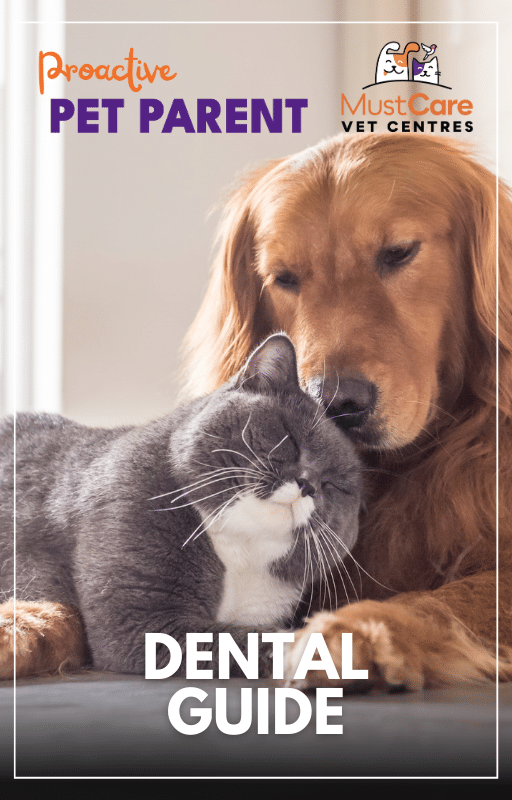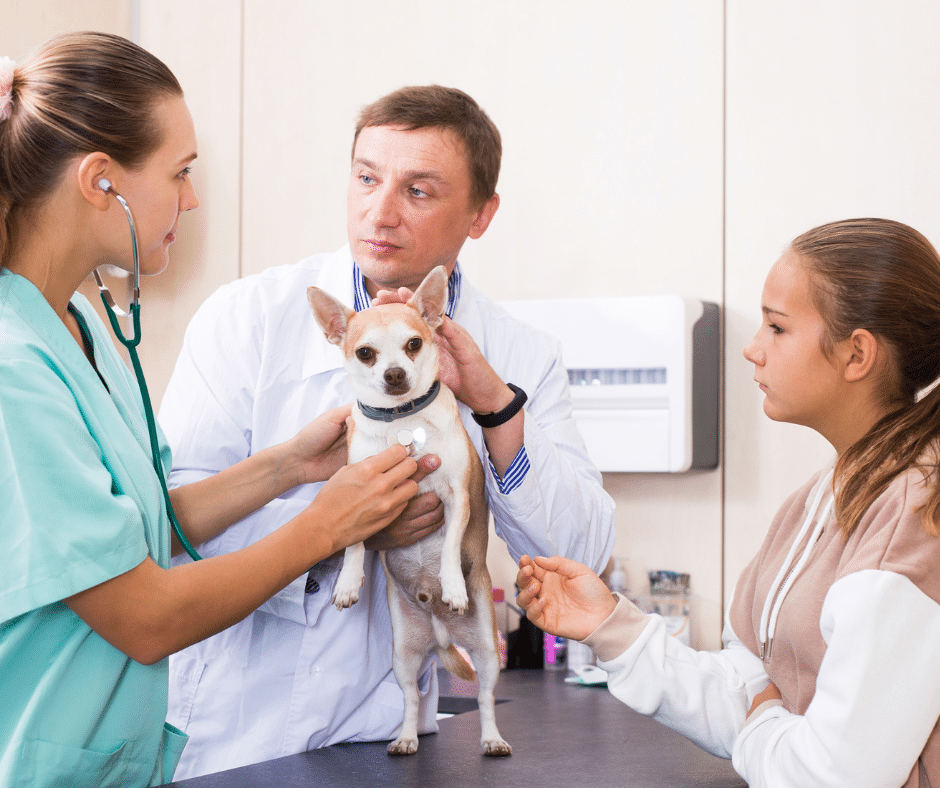Share This Blog With Other Pet Parents!
When to Worry About Pet Lumps: A Guide for Pet Owners
Discovering a lump on your pet can be a heart-stopping moment. “When to Worry About Pet Lumps: A Guide for Pet Owners” delves into this critical topic, offering valuable insights and guidance. As pet owners, we often grapple with questions like, “Is this lump harmless or a sign of something serious?” We’ll explore how to identify different types of lumps, understand their potential implications, and determine when it’s time to seek professional veterinary advice. Whether you’re a seasoned pet parent or new to the journey, this guide is an essential tool to ensure the health and happiness of your furry family members.
What you’ll learn from this blog:

For all you need to know, download our
FREE Dental Guide
This blog is part of our Proactive Pet Parent series! This is just the beginning… To see more blogs, click here! Better yet, sign-up to our newsletter to receive these directly to your inbox each month.
Sign-up To The Proactive Pet Parent Newsletter
Understanding Pet Lumps
When we talk about lumps in pets, it’s crucial to understand that they come in various forms and arise from different causes. Broadly, these lumps can be classified into two categories: benign and malignant. Benign lumps are non-cancerous and often pose no serious threat to your pet’s health. They include growths like lipomas, which are soft, fatty lumps typically found beneath the skin and are more common in older pets. Another benign type is a cyst, a small sac filled with fluid or other material, which can develop due to blocked glands or other non-cancerous conditions.
On the other hand, malignant lumps are more serious as they represent cancerous growths. These can aggressively affect surrounding tissues and may spread to other parts of the body. Malignant lumps require prompt veterinary attention and treatment.
Apart from these, pets can also develop abscesses, often resulting from infection. Abscesses appear as swollen, painful areas and may rupture, releasing pus. While they might seem alarming, they are generally treatable with antibiotics and proper care.
It’s vital to recognize that not all lumps can be easily categorized without professional evaluation. Factors like the lump’s growth rate, texture, and location play a significant role in determining its nature. A lump that rapidly increases in size, changes shape, or becomes painful to touch, warrants a closer examination by a veterinarian. Regular petting and grooming sessions with your pet can be an excellent way to spot any new or changing lumps early on, ensuring timely intervention.
Understanding these different types of lumps and their potential implications is the first step towards proactive pet health management. It sets the stage for informed discussions with your vet and aids in early detection, which is crucial for effective treatment.
Identifying Suspicious Lumps
While many lumps are benign, certain characteristics can signal the need for veterinary attention. One of the primary red flags is rapid growth. A lump that quickly increases in size over days or weeks should be examined by a vet. Similarly, lumps that are hard or firm to the touch, as opposed to soft and movable, can be more worrying.
Another aspect to consider is the location of the lump. Lumps near lymph nodes, such as under the jaw, behind the knees, or in the groin area, can be particularly concerning. These areas are prone to swelling due to lymphatic issues, which can be a sign of more serious conditions.
Changes in color or texture are also noteworthy. If a lump becomes red, inflamed, starts to bleed, or changes in any noticeable way, it’s time to consult your vet. Additionally, any lump that seems to cause discomfort or pain to your pet when touched or manipulated is a cause for concern.
It’s essential to remember that some lumps can be deceptive in their appearance. For instance, a small but rapidly growing lump could be more alarming than a larger one that has remained the same size for a long time. The key is to monitor any new growths or changes in existing lumps and not to delay veterinary consultation. By maintaining a regular check-up routine and being vigilant about changes in your pet’s body, you can play a pivotal role in safeguarding their health.
When to Seek Veterinary Help
Early detection and treatment for pet lumps often lead to better outcomes, especially in cases where the lump may be malignant. Here are key scenarios and symptoms that warrant a visit to the veterinarian:
- Rapid Growth: If you notice a lump growing quickly over a short period, it’s time for veterinarian assessment.
- Change in Behavior: Observe your pet for any signs of discomfort, such as persistent licking, biting, or scratching at the lump site. Changes in behavior like lethargy or loss of appetite can also indicate underlying issues.
- Painful or Sensitive Lumps: If your pet shows signs of pain or discomfort when you touch the lump, it needs to be checked by a vet.
- Lumps That Bleed or Ooze: Any lump that bleeds, oozes, or looks infected should be examined immediately.
- Multiple Lumps: The presence of multiple lumps can be a sign of more systemic issues and should prompt a vet visit.
- Change in Size, Shape, or Texture: Any significant changes in a lump’s characteristics are a red flag.
It’s important to note that some lumps may not be immediately concerning but should still be monitored. If you’re ever in doubt, it’s better to err on the side of caution and have a vet evaluate the lump. Regular health check-ups and discussing any new lumps or changes in existing ones with your vet during these visits can help catch potential issues early. As a pet owner, you know your pet best. Trust your instincts and seek professional advice when something seems off.
The Veterinary Examination Process
Understanding what happens during a veterinary examination can alleviate much of the anxiety associated with bringing your pet in for a lump check. When you visit the vet, the process typically begins with a physical examination. The vet will carefully examine the lump, noting its size, shape, consistency, and whether it’s fixed to the underlying tissue or freely movable. They will also assess the overall health of your pet, looking for any other symptoms that might be related.
Depending on the initial assessment, the veterinarian may recommend further diagnostic tests. One common procedure is a fine needle aspirate, where a small needle is used to collect cells from the lump for microscopic examination. This test can often determine the nature of the lump without the need for surgery.
In some cases, more comprehensive testing like a biopsy may be necessary. A biopsy involves taking a small tissue sample from the lump, which is then analysed in detail. This test provides a clearer picture of whether the lump is benign or malignant and helps in planning further treatment.
Imaging tests, such as X-rays or ultrasounds, might also be used to assess the lump’s impact on surrounding tissues or to check for spread in the case of suspected cancer.
It’s important to note that not every lump will require all these tests. The vet will decide on the most appropriate course of action based on the lump’s characteristics and your pet’s overall health. Keep in mind that the goal of this process is to ensure the best possible care for your pet, whether the lump turns out to be a simple cyst or something requiring more attention.
Finally, always feel free to ask questions during your vet visit. Understanding each step of the examination and the reasons behind different tests can provide peace of mind and help you make informed decisions about your pet’s care.
Treatment Options and Care
Once a diagnosis is made, if the lump is found to be of concern, there are several treatment paths that your veterinarian might suggest. The course of action largely depends on the type and severity of the lump.
For benign lumps that don’t pose a threat to your pet’s health, monitoring may be the recommended approach. This involves keeping an eye on the lump for any changes in size, shape, or behaviour. In such cases, no immediate action is necessary, but regular check-ups are crucial to ensure the lump doesn’t evolve into a more serious condition.
Surgical removal is often considered for lumps that are malignant or cause discomfort to your pet. Surgery aims to remove the entire lump and, in the case of cancerous tumours, any affected surrounding tissue. Post-surgery, your pet might require additional treatments like chemotherapy or radiation therapy, depending on the malignancy’s nature.
Medication may also be prescribed in certain cases, especially if the lump results from an infection or inflammatory condition. These medications can include antibiotics, pain relief, or steroids to reduce swelling and discomfort.
At-home care plays a vital role in your pet’s recovery and overall well-being. This includes ensuring they have a comfortable place to rest, keeping their environment calm and stress-free, and following any dietary guidelines provided by your vet. Additionally, you’ll need to monitor the surgery site or the lump (if not removed) for any signs of infection or changes.
Remember, the best care approach is one that’s tailored to your pet’s specific needs. Your vet will guide you through the options, considering your pet’s age, overall health, and the lump’s characteristics. Open communication with your veterinarian is key to ensuring your pet receives the most appropriate treatment and care.
Preventive Measures and Regular Check-ups
Prevention and regular veterinary check-ups are pivotal in maintaining your pet’s health and detecting potential issues early, including the emergence of lumps. Engaging in regular health checks at home is one of the most effective ways to stay on top of your pet’s wellbeing. This involves routinely inspecting your pet’s body for any new growths or changes in existing ones, especially as they age. Familiarise yourself with their skin and coat during daily activities like petting or grooming, as this can help in early detection of abnormalities.
A healthy lifestyle is equally important in prevention. Ensure your pet maintains a balanced diet, gets adequate exercise, and avoids exposure to harmful substances. Obesity in pets, for instance, can make it harder to spot lumps and might even contribute to certain health issues.
Routine veterinary visits are crucial. These check-ups allow professionals to examine your pet thoroughly and identify issues that might not be immediately apparent to you. During these visits, discuss any concerns or observations you have about your pet, no matter how small they may seem. It’s also a good opportunity to talk about your pet’s diet, exercise routine, and any preventive measures you can take at home.
While not all lumps can be prevented, early detection and intervention can significantly impact the outcome. Establishing a habit of regular home check-ups, maintaining a healthy lifestyle for your pet, and ensuring consistent veterinary care are key steps in safeguarding your pet’s health. By being proactive in these areas, you not only contribute to your pet’s longevity but also enhance their quality of life.
Next Steps
It’s important to acknowledge that dealing with your pet’s health issues, such as discovering a lump, can be an emotionally taxing experience. It’s natural to feel a range of emotions, from worry to uncertainty. However, it’s also empowering to know that taking prompt action can make a significant difference in your pet’s health. Early detection and intervention, guided by the expertise of veterinary professionals, can lead to more positive outcomes.
The advancements in veterinary care are reassuring, offering a range of options for diagnosis and treatment that were not available in the past. Veterinarians today have access to sophisticated tools and treatments that can effectively manage many health issues pets face. Your vet is your partner in ensuring the health and wellbeing of your pet. They understand the emotional bond you share with your pet and are there to provide both medical care and emotional support.

